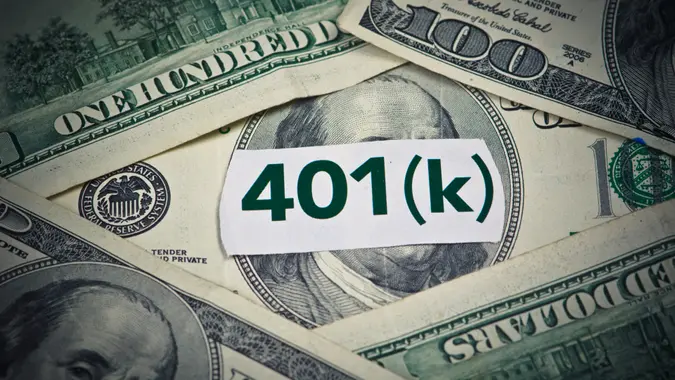What Does Vested Mean in Your 401(k)? Simple Guide to Keep Every Dollar You Earn

Commitment to Our Readers
GOBankingRates' editorial team is committed to bringing you unbiased reviews and information. We use data-driven methodologies to evaluate financial products and services - our reviews and ratings are not influenced by advertisers. You can read more about our editorial guidelines and our products and services review methodology.

20 Years
Helping You Live Richer

Reviewed
by Experts

Trusted by
Millions of Readers
If you’re wondering “what does vested mean in 401k?” here’s the short answer — it’s the amount of your retirement savings you truly own, especially the money your employer contributes.
When you’re vested, it means you get to keep those funds even if you leave your job. You’re always 100% vested in the money you contribute, but your employer’s match might take time to fully belong to you.
Understanding how vesting works can help you make more informed career decisions and avoid leaving thousands of dollars on the table.
Quick Facts: What Vested Means in a 401(k)
| Key Detail | Quick Summary |
|---|---|
| Definition | The portion of your 401(k) you fully own |
| Your Contributions | Always 100% vested immediately |
| Employer Match | Becomes yours based on the vesting schedule |
| Typical Vesting Schedule | 3-year cliff or 6-year graded |
| Why It Matters | Leaving early could mean losing your employer match |
| Smart Tip | Stay until you’re fully vested to keep your full benefit |
In short: “Vested” means how much of your employer’s contributions you truly keep — and it can make a big difference over time.
What Does Vested Mean in a 401(k)?
Here are the basics you’ll need to know when it comes to your 401(k) vesting options:
Simple Definition — What “Vested” Really Means
Being vested means ownership. It’s the part of your 401(k) balance you get to take with you if you leave your job. While your contributions are always yours, the company’s matching funds may require you to stay for a certain amount of time before they become fully vested.
According to the Department of Labor, employers use vesting to encourage employees to stick around longer — most 401(k) plans must fully vest workers within six years or less.
Your Contributions vs. Employer Contributions
- Your contributions: Always 100% yours, from day one.
- Employer contributions: Gradually become yours based on your company’s vesting schedule.
If your company matches 4% of your salary and you leave before being fully vested, you could lose that matched portion. Over time, that’s a big deal. Vanguard data shows the average employer match accounts for nearly 25% of total 401(k) growth during an employee’s tenure.
Why Employers Use Vesting Schedules
Vesting schedules are a retention tool. They reward loyalty — the longer you stay, the more of your employer’s contribution you keep. This structure encourages long-term employment and helps companies retain talent.
Types of 401(k) Vesting Schedules
Every company handles vesting differently, but most use one of three structures.
1. Immediate Vesting
You’re fully vested the moment contributions are made. This means every dollar your employer adds is yours right away. It’s rare but valuable.
2. Cliff Vesting
You gain 100% ownership after a set number of years, often three. Before that point, none of the employer match belongs to you.
3. Graded Vesting
Ownership builds gradually, usually over six years. For example, you might gain 20% each year until you’re fully vested by year six.
Example 401(k) Vesting Schedules
| Year | Immediate Vesting | Cliff Vesting (3 years) | Graded Vesting (6 years) |
|---|---|---|---|
| Year 1 | 100% | 0% | 20% |
| Year 2 | 100% | 0% | 40% |
| Year 3 | 100% | 100% | 60% |
| Year 4 | 100% | 100% | 80% |
| Year 5+ | 100% | 100% | 100% |
If you’re only six months away from full vesting, staying could mean keeping thousands in employer-matched funds.
Why Vesting Matters for Retirement Planning
So now that we know what vesting is, how exactly does it actually impact your retirement savings and plan? Let’s get into it:
Leaving Before You’re Fully Vested
If you leave your job before you’re fully vested, you could lose part or all of your employer’s contributions.
A study by Penn State and Yale law schools, which used IRS data to make their findings, found that 1.8 million participants forfeited an estimated $1.5 billion in unvested employer contributions after leaving their jobs.
Impact on Employer Match and Long-Term Growth
Your employer match is a huge part of your retirement growth. Fidelity research shows that getting the full match can boost your retirement savings by up to 25% over a career, thanks to compound growth.
Why Vesting Impacts Your Future 401(k) Balance
| Scenario | Employer Match Kept | Lost Match | 20-Year Growth (7% return) |
|---|---|---|---|
| Leaves After 2 Years | 40% vested | 60% lost | $18,000 |
| Leaves After 5 Years | 100% vested | 0% lost | $45,000 |
A few extra months on the job could mean tens of thousands more in retirement savings.
Tax Implications of Vested vs. Unvested Funds
Vested funds are tax-deferred until you withdraw them in retirement. Non-vested funds aren’t yours, so they’re not taxable. That means any forfeited money simply stays in your employer’s plan.
Long-Term Value of Staying Until Fully Vested
If you’re close to full vesting, it’s often worth waiting. Staying even one extra year to reach full vesting can add the equivalent of $30,000 to $50,000 in lifetime 401(k) value, depending on your salary and match rate.
How to Maximize Your 401(k) Vesting Benefits
Here are some tips and advice for making the most of your 401(k) vesting options ahead of retirement:
1. Learn Your Company’s Vesting Schedule
Check your plan documents or ask HR. Knowing your schedule helps you plan job changes strategically.
2. Time Job Changes Carefully
Leaving just before a vesting date can mean losing money. If you’re six months away from full vesting, waiting can pay off big.
3. Always Contribute Enough to Get the Full Match
Don’t miss out on free money. If your company matches up to 4%, aim to contribute at least that much.
4. Roll Over Your Vested Funds
When you change jobs, roll over your vested balance into your next 401(k) or an IRA to keep your savings growing. You can estimate your future value using the GoBankingRates Retirement Calculator.
Final Take to GO: Vesting Protects Your Retirement Future
Understanding what vested means in your 401(k) helps you make smarter financial moves. By knowing your company’s vesting schedule — and waiting until you’re fully vested — you keep more of your employer’s match and set yourself up for stronger long-term growth.
If you’re unsure where you stand, check your HR portal or talk to a financial advisor. A few informed decisions today can lead to a bigger retirement tomorrow.
FAQs: Understanding 401(k) Vesting
Here are the answers to some of the most frequently asked questions about 401(k) vesting and how it works:- What does it mean to be fully vested in a 401(k)?
- Being fully vested means you own 100% of your 401(k) balance, including your employer’s contributions.
- Do I keep my 401(k) if I leave before being vested?
- You always keep your contributions. Any unvested employer match is forfeited when you leave early.
- How long does it take to be 100% vested?
- Most plans follow a 3-year cliff or 6-year graded schedule, per the Department of Labor.
- What happens to unvested 401(k) money?
- You lose access to unvested funds. That portion stays with your employer’s plan.
- Are employee contributions always vested?
- Yes -- 100% of your own contributions are always yours, regardless of when you leave.
Information is accurate as of Oct. 23, 2025.
Our in-house research team and on-site financial experts work together to create content that’s accurate, impartial, and up to date. We fact-check every single statistic, quote and fact using trusted primary resources to make sure the information we provide is correct. You can learn more about GOBankingRates’ processes and standards in our editorial policy.
 Written by
Written by  Edited by
Edited by 

























